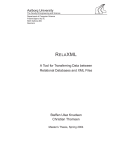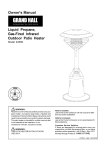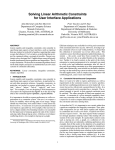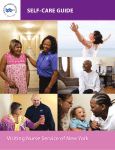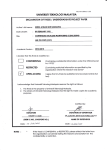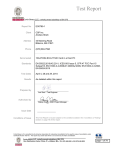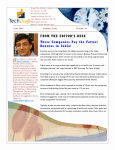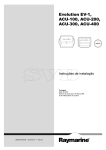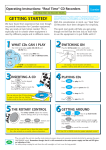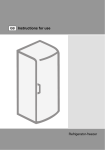Download IML HIV kit user manual
Transcript
© Thoughtshop Foundation 2005 www.thoughtshopfoundation.org About this Package It's My Life ! is a series of participatory learning tools developed as a part of an intensive youth empowerment programme. These tools have been designed and tested to be adaptable for different literacy levels, group sizes and available time. This kit is one of the It's My Life ! components. To maximise impact and time effectiveness, the curriculum has been whittled to three core issues Understanding infection, Risk Perception and Social Issues. Each issue is discussed within a structured and stimulating multimedia activity. It takes about 2 hours to conduct the complete session. The package is simple enough to be used by peer educators. Rather than deal with theoretical and historical information about HIV, this package directly raises issues related to attitudes and behaviour change amongst young people. Information about sex and sexuality is openly discussed, acknowledging the different kinds of experiences young people are likely to go through. Issues related to gender inequity and sexual orientation are touched upon. This package does not include details on condom use, because many schools / colleges / communities do not permit condom demonstration. This package touches upon STI without going into specific details such as different STIs, visuals of symptoms etc. Specific information about medicines, vaccines, tests and costs are not included because of regional variations and rapid change. The educator may need to keep abreast of the current developments. The facilitator may consider using separate kits to reinforce different aspects of HIV/AIDS/STI awareness. Please see Appendix 4 for other available material. Contents Page Introduction 2 Using this Kit 2 Important Instructions for handling chemicals 3 Exercise 1 Magical Demonstration 4 Exercise 1 Sum Up 6 Exercise 2 Risk Game 7 Exercise 2 Reference 9 Exercise 2 Sum Up 11 Exercise 3 Audio Quiz 13 Exercise 3 Reference 14 Exercise 3 Sum Up 19 Appendix 1 : Frequently Asked Questions 20 Appendix 2 : Sample Pre-post Questionnaire 21 Appendix 3 : Glossary 22 Appendix 4 : Other material developed by us 23 1 Introduction Here are a few points to set a context to the workshop on HIV/AIDS awareness. These points can be used to influence Principals about the need for such programmes and also for students to realise the gravity of the situation. Twenty five years ago, hardly anyone knew of HIV/AIDS. Today it How can we prevent HIV/AIDS? Experience from around the world has shown that it is necessary to educate young people about the process of growing up and its implications. Educating young people on family life education, HIV/AIDS and life skills will enable them to develop a strong value system and adopt a responsible lifestyle. Young people can also be agents of change and spearhead advocacy for HIV/AIDS education among peers, community members, family etc. Empowerment through knowledge and skills will help young people make correct choices and prevent further spread of HIV/AIDS. is one of the biggest concerns all over the world. No one knows exactly where the Human Immunodeficiency Virus originated or the conditions that led to its spread among the early 1980s. It may have lived in a latent form for very many years. Here are some things about the virus that we do know: The first case of HIV infection was identified in 1986 in India. Today there are an estimated 40 million people infected with HIV in the world. UNAIDS estimate There are an estimated 4 million people living with HIV/AIDS in India 2002. That is 10% of the worlds HIV/AIDS population. Nearly half of all new infections are occurring among people in the 15-24 age-group. Many of them do not know they are carrying the virus. In 8 out of 10 cases, the virus is spread through the sexual route. Worldwide HIV/AIDS is the fourth biggest killer. HIV/AIDS cannot be cured but it can be prevented 2 Using this kit It takes about 2 hours to conduct the entire session. This kit can be used in a group size ranging from 10 - 50. The kit is ideally used with people who are 16 years and over. HIV/AIDS education is most effective with groups who have already received sex education. The package is designed to involve all the participants through the various activities. The facilitators role as a magician, educator and quiz master is important and the facilitator should be well rehearsed before conducting the session. To conduct the workshop efficiently, at least one co-facilitator or helper is necessary. The co-facilitator can keep the material for each activity ready before it starts and also collect the material after each activity. A glossary of terms has been provided to the help the facilitator clarify terms and practices that the group may not be familiar with. Contents of the package Attention ! 1. One Guide book For instructions and guidelines to be followed by the facilitator Important information about the chemicals included in this kit. 2. Transparent cups, botle with liquid (indicator), bottle with powder (chemical), spoon For exercise 1 > Magical Demonstration To show how HIV spreads and how it is detected 3. One pack of 21 cards For exercise 2 > Risk Game To explore how risky certain real life situations are in the context of HIV/AIDS transmission 4. One audio tape For exercise 3 > Audio Quiz To explore certain real life social issues around HIV/AIDS Side A : Hindi/Bengali plays, Side B : English plays Check ! Before the workshop starts, make sure You have photocopies of the pre and post test questionnaires. All the cups are all washed clean. The chemical and indicator bottles are handy. The 21 cards required for the second exercise are sorted. The tape recorder is working and the cassette is rewound to the correct side. About the Powder The white powder provided is Potassium Carbonate (K2C03) This is a salt that dissolves in water and becomes invisible. In the process it becomes an alkaline solution. Use the plastic spoon provided to make the solution. For the trick to work well, it is necessary to use commercially available packaged/bottled water. This will ensure that the solution remains invisible. Keep the bottle in the kit, closed when not in use, in a cool dry place away from direct sunlight. Keep out of reach of children. About the Liquid The liquid (labeled Indicator) is phenolphthalein dissolved in rectified spirit. Just one drop is enough to test each cup. If the solution is alkaline, it will turn bright pink. If new cups are not used for every workshop, it will bes necessary to wash the cups well after every workshop. Keep out of reach of children. 3 Exercise 1 > Magical Demonstration To show how HIV spreads and how it is detected Materials Required: 10 cups for participants, 2 cups for demonstration, testing solution, powder, indicator, packaged/bottled water. Time : 15 minutes Step 1 : Before the exercise starts Have 12 cups ready half filled with water. 10 will be given to participants and 2 will be used for demonstration by the facilitator. In one of the 10 cups meant for the participants, dissolve one spoon of the powder. Make sure it is well dissolved and the cup looks like it containers water just like the other 10 cups. In one of the cups meant for demonstration dissolve one spoon. Keep the 2 demonstration cups aside. Keep the 10 participants cups ready for distribution Step 2 : Ask 10 volunteers to come forward for this game 4 Ask them to stand in a semi circle facing the group. Give each volunteer a cup half filled with water. Tell the group: Each cup represents our body. The liquid inside is our body fluid. Find a partner to exchange your body fluid with. You can have as many partners as you like. Tell them: To exchange body fluids, they must empty their cup into the partners cup and then pour back until both cups have the same amount of fluid they started with. Encourage people to move around and exchange body fluids for a minute. After that ask them to stop and return to their positions in the semi circle with their cups. Step 3 : Hold the demonstration glasses up to the large group Show them that both cups have clear fluid. Tell them that one cup has an invisible agent; like HIV in the human body. It is impossible to tell which one, just by looking. The only way is to apply a special test. In this case the infected glass will turn pink. HIV too is detected in the human body only through certain blood tests. Sprinkle the testing agent in each of the demonstration cups. One will remain as it is. The other will turn bright pink. Tell the group: only 1 of the cups that participants are holding had the same invisible agent. Ask the group: Now that fluids from have mixed, how many cups do they think will turn pink. Let us see! Step 4 : Test the 10 individual cups Put a drop of indicator in each cup. Infected cups will turn pink. Re iterate the fact that only one cup was infected at the beginning. Ask all the infected volunteers to stand on one side. Ask them how they think they got infected. Step 5 : Wind up Collect the cups from the volunteers, thank them for their participation and ask them to return to their seats. Share the sum up points with the entire group once everyone is back in their place and you have their attention. The sum up points are listed in the next page 5 Exercise 1 > Magical Demonstration > Sum up 6 1. The Human Immunodeficiency Virus or HIV spreads when certain body fluids of an infected person pass into the body of another person. By certain body fluids we mean blood, seminal fluid and vaginal fluid. 2. HIV is the virus that causes AIDS (Acquired Immune Deficiency Syndrome). AIDS is the late stage of HIV infection. AIDS happens when a persons immune system breaks down and he/she becomes too weak to fight off infections. AIDS may take several years to develop. 3. In most cases, HIV is passed from one body to another through unprotected sexual intercourse. 4. Some ways of avoiding the risk of HIV infection through the sexual route of transmission are: Using a condom correctly Practicing safer sex where there is no penetration or exchange of body fluids Having a single uninfected faithful partner Not having sex 5. HIV can also spread Through transfusion of unscreened (untested) Blood Through sharing of contaminated syringes or needles Through an HIV infected mother to her child during pregnancy, birth or breast-feeding 6. You cannot tell by looking at a person whether he or she is infected. 7. The only way to tell is through certain blood tests. (for example ELISA, Western Blot, PCR) Exercise 2 > Risk Game To explore the degree of risk that various activities have If the explanation is not according to the expected responses (refer to the list on the next page), the facilitator must invite discussion within the larger group and guide the final response. After explaining the participants must wait at a corner Step 4 : Group participants according to card colour Materials Required: Pack of Cards, this Flipchart After all the cards have been discussed ask the participants to separate into 3 groups according to card colour. There should be 9 people each in the green card and orange card group, and 3 people in the yellow card group. Time : 45 minutes Step 1 : Explain to the group By Risk we mean the risk of contracting a Sexually Transmitted Infection or HIV. STIs are infections that spread mainly through sexual contact. Some examples of STIs are Syphyllis and Gonorrhoea. Some common symptoms of STIs are pain in the genital area, pus discharge, sores, blisters, rashes (in the genitals and the mouth). If a person has sex with somebody who has a STI they are most likely to contract it as well. Most STIs can be cured if treated early, however some have very serious consequences. Untreated STIs make it easier for HIV to enter the body. It is important for both partners to complete the treatment for STIs as they can recur. Step 2 : Distribute cards to the group Distribute the cards among the participants individually or in small groups depending on the group size. Tell the participants that they have to assess the activity described in the card based on whether they think it is low risk, high risk or no risk in the context of Sexually Transmitted Infections and HIV transmission. Give the participants / groups a few minutes to prepare themselves. Step 3 : Call up participants to explain their card Invite the participants to come to the centre and read out their Step 5 : Explain to the group All green cards represent activities that carry no risk of HIV or STI. All yellow cards represent activities that are safe from HIV infection, but may carry risk of STI. All orange cards represent activities that are highly risky in the context of HIV and STI. Let the green card holders quickly read out their cards for everyone. Step 6 : Wind up Collect the cards from the participants, thank them for their participation and ask them to return to their seats. Next page has a list of all the cards and expected responses. The facilitator must invite and guide discussions wherever necessary. Note The Facilitator must encourage every participant to apply the thumb rule of whether specific body fluids are being exchanged or not. It helps to carry back a simple rule that helps in deciding whether an activity is risky or not. 7 8 Exercise 2 > Risk Game > Reference Sharing a glass of water with an HIV infected person No Risk. There is no exchange of blood, seminal or vaginal fluids. Having sex with a person having an Sexually Transmitted Infection High Risk. Sexually Transmitted Infection makes it easier for HIV to enter the body. Deep Kissing Low Risk. No exchange of blood, seminal or vaginal fluids. Hugging No Risk. There is no exchange of blood, seminal or vaginal fluids. However in the rare situation that both partners have cuts in the mouth resulting in exchange of blood it could be slightly risky. Some risk of contracting STIs remains. Giving Blood Having many sexual partners High Risk. If no condom is used there is exchange of blood, seminal or vaginal fluids. No Risk. There is no exchange of blood, seminal or vaginal fluids. Donating blood saves lives and must be encouraged. Having sex with a healthy looking person No Risk. There is no exchange of blood, seminal or vaginal fluids. High Risk. If no condom is used there is exchange of blood, seminal or vaginal fluids. You cannot tell from outside whether a person is infected or not. Getting Drunk Writing Love Letters Can be risky as being drunk means not being in control and that could result in forgetting to use a condom. No Risk. There is no exchange of blood, seminal or vaginal fluids. It is a safe way to show affection. Holding Hands 9 Having sex without a condom just once High Risk. There is exchange of blood, seminal or vaginal fluids. Even one risky encounter can be infectious. Abstinence or not having sex No Risk. There is no exchange of blood, seminal or vaginal fluids. Being friends with a person who is HIV+ No Risk. There is no exchange of blood, seminal or vaginal fluids. HIV does not spread through social contact. Having sex with an older person High Risk. There is exchange of blood, seminal or vaginal fluids. Having sex with a sex worker High Risk. If no condom is used there is exchange of blood, seminal or vaginal fluids. However it is not necessarily more risky than an unprotected sexual encounter with any other person. Masturbating No Risk. There is no exchange of blood, seminal or vaginal fluids. Having a sexual partner who is from a well to do family High Risk. If no condom is used there is exchange of blood, seminal or vaginal fluids. Status of family is not relevant. Having sexual activity without intercourse Low Risk. No risk of HIV as there is no exchange of blood, semen and vaginal fluids. However some STIs can be transmitted through intimate body contact. 10 Sexual intercourse using condom Low Risk. No risk in the context of HIV only if a condom is used correctly every time. However some STIs can be transmitted through intimate physical contact. Anal Sex High Risk. The anal passage is tight and can tear easily during penetration which would provide a direct route for HIV transmission. There is need for care even with condom use as condoms may tear. Being a virgin No Risk. As it implies no sexual activity and therefore no exchange of body fluids. Exercise 2 > Risk Game > Sum up 1. Any activity where there is exchange of blood, seminal and vaginal fluids carries risk of HIV or STI infection. 2. The relationship between STI and HIV is two fold: a. STIs are an indicator for high risk behaviour; unprotected sexual intercourse with multiple partners (the same risk behaviour that results in HIV transmission) ; and b. STIs damage the genital area making it easier for HIV to be transmitted. Thus controlling STIs can contribute to significantly reducing HIV transmission. 3. STIs should be treated as soon as possible by a registered doctor and the course of medicines should be completed to fight the infections effectively. 4. Anyone who suspects that he or she might be at risk of HIV infection, should contact a Doctor or a VCCTC centre to receive confidential, counselling and testing for HIV. 5. Anyone going for the ELISA test for HIV should know about the Window Period. This is the time taken for the antibodies to the HIV to form within the human body. It varies from 6 to 12 weeks from the date of suspected infection. If ELISA or Western Blot are conducted within this period, they lose their effectiveness since they detect the presence of antibodies to HIV in the body. 6. For details about where to go for STI treatment, HIV counselling and testing, costs etc., call ASKline 24176128 in Kolkata or any helpline in your city. 11 12 Exercise 3 > Audio Quiz Step 4 : Wind up To help understand social Issues around HIV/AIDS Materials Required: Audio Player, Tape, this Flipchart, Scoreboard Time : 60 minutes There are three questions for each skit. There are 5 skits in all. At the end of the quiz add up the score and announce it to the group. Share sum up points with the entire group once you have their attention. The topics for the plays are 1. Step 1 : Before the exercise starts Check that the player is working, and the cassette is rewound to the appropriate side according to the language of the session (Side A is in Hindi/ Bengali, Side B is in English) Check that the volume is adjusted so everyone can hear. Organise a score board and score keeper Step 2 : Create Teams and start the Quiz Divide the participants into 3 teams. Team A, B and C. Tell the group: We are now going to have a quiz to see how well we understand some social issues around HIV/AIDS. Ask the group to listen carefully. Play the first skit. Put the first question to Team A. Tell them to discuss it in their team and then answer. If they answer correctly give them 10 points. If they answer partially correctly give them 5 points. If they are completely wrong give them 0. With a partially correct or wrong answer the question should pass to the next team. 2. 3. 4. 5. Role of parents in imparting and sex education HIV/AIDS education Drugs and HIV Safe sex and HIV How HIV is not transmitted Treatment and Caring for people with HIV/AIDS Note Some topics have been omitted from this kit to keep within the usual time constraints. However an additional cassette and questionnaire is available, which deals with the following issues: 1. 2. 3. 4. 5. 6. Blood and HIV Safe sex and HIV HIV and Motherhood Testing for HIV Treatment and Caring for people with HIV/AIDS HIV at the Workplace These topics may be included if this kit is used in organisations. Please see Appendix 4 for other Kits that are available. Step 3 : Repeat correct answer after every response After the team has answered, re-enforce the correct response. Read out the answer from the flipchart if necessary. If there are any doubts or questions, allow discussions, but keep them short 13 Exercise 3 > Audio Quiz > Reference Play 1 > Role of Parents Mother: Chee! Chee! Seema. Such a disgrace. Didnt you think even once about us, or the reputation of the family? What were you thinking Seema...going out with that no good loafer? Look at you now ! Shame on you Seema, and you brought all this shame upon us. I cant even imagine what everyone will think...Oh God! Why did I have to live to see this day! Father: Look at what your liberal upbringing has done to your precious princess. Its all your indulgence that has gone to her head...Did I not tell you, all that freedom is not good for a grown up girl in the house... Seema: But Ma, Baba, it all happened so suddenly... I did not know I could get pregnant...How could I have known...? Father: You dare talk back to your parents? Shameless girl ! Instead of repenting, now you want to justify yourself? (sound of a huge slap and sobbing follows ) Questions 1. Do you think this situation could have been avoided? If so, how? The situation could have been avoided if Seema had received sex education. It is the parents responsibility to talk to children about relationships, bodily changes, dealing with the opposite sex. Seemas parents should have been frank and friendly with her. 14 Adolescents require a lot of love and support. When they do not get these at home, they look for it elsewhere, usually from a member of the opposite sex. This need for emotional support coupled with an awakening sexuality often leads to a great deal of trouble. 2. Is Seema at any other physical risk besides pregnancy? Since Seema and her boy friend did not use any protection she is also open to the risk of having contracted a sexually transmitted infection or HIV. 3. Would it have been any different or how would it have been if there had been a boy in Seemas place? In our male dominated society it is always more difficult for a woman, as she has to bear the pregnancy. She cannot run away from it as it is something that is developing inside her. A boy in Seemas place would probably get a bad name for a while. He would also remain open to the threat of a sexually transmitted infection or HIV. Exercise 3 > Audio Quiz > Reference 2. How do you think the youth can be deterred from taking drugs? Play 2 > Drugs and HIV Father: This is unbelievable ! Have you read the papers today? One article here says everyday thousands of teenagers in this country are getting addicted to drugs. Apparently a a large number of these young people are also getting infected with HIV because they share needles which are used to inject drugs. Mother: Good God ! You know this kind of news gives me sleepless nights about our Binnoo. Just think, he has just started college...god only knows what kind of friends hes making...Do you think, maybe, we can try talkng to him about all it? Father: Oh Nonsense ! Im not worried about Binnoo at all. He will never get into such things. After all he has inherited our family heritage of highest moral standards...Its all there in his blood ... Besides you should understand the boys psychology. You see discussing things like that may only arouse his curiosity. So dont start talking to him about drugs ok? and stop worrying for once... Young people can be deterred from taking drugs a. if the whole curiosity surrounding drugs is removed by parents, teachers and other influencers b. if the home environment is kept healthy and happy c. if the parents are friendly and supportive towards their kids 3. How exactly is taking drugs related to HIV/AIDS? Drug addicts sometimes use syringes to inject the drug into the blood. After use, a minute quantity of blood may be left on the syringe needle. If this syringe is shared, the blood of different users can enter the body of those sharing the needle. If one of the users has HIV, there is a risk that all those who shared the syringe can get the virus. Wife: Whatever you say...But I cant stop worrying aboutmy only son... Questions 1. Why do you think the youth try drugs? The youth experiment with drugs for various reasons: peer pressure, family problems /pressures, curiosity, to cope with failure / low self esteem. 15 Exercise 3 > Audio Quiz > Reference Play 3 > Safe Sex and HIV Saurav: Hey Ajay, heard about Dileep? Bad scene, No? Ajoy: No, What are you talking about? Saurav: Poor chap is quite shaken up. The thing is, he had visited one of those women get what I mean? Ajoy: Oh that, yeah! We had talked about it when he was planning to go. According to me it was avery bad idea, and I told him as much. So finally he did visit a woman did he? And whats he so shaken up about? Saurav: What do you think?. He has fallen sick. He looks very worn out, poor chap. He is not saying it, but obviously he is worried to death. Probably thinks hes got the HIV... Ajoy: By God ! Dont tell me he didnt use a condom...I swear, I must have told him fifty times ! I said always keep one in your pocket just incase... Saurav: Guess what he says ! He says it happened so quickly that it did not occur to him to put it on ...! Can you believe it? Ajoy: Really man...Bad scene isnt it...if he only used a little more control... Questions 1. Is there anything in the skit that suggests that Dileep is at any risk? Dileep probably did not use a condom. He is definitely at the risk of having contracted an STI, maybe even HIV. 16 2. Do you think it would have been safer if Dileep had been to any other women other than those women? The risk would have been the same. It is near impossible to tell about the persons sexual history, or whether the person is infected or not, by just looking at a person. 3. What should Dileep do? If he has any symptoms of an STI he can go to a doctor and get it treated. He should avoid all sexual activity and complete the course of medicines. He can also go for an HIV test after the window period. He should ask for pre and post test counselling so he is mentally prepared for the experience. Exercise 3 > Audio Quiz > Reference Play 4 > Ways in which HIV does not transmit Gupi: Hey Bobby, Baatik Babu is coming this way Bobby: I bet he will start talking about his pet paranoia again Gupi: Good Morning Baatik Babu! Whats the story with your new hairstyle? Unless you are planning to take up sanyas, Id say your haircut is about six months overdue. BB: No, no barber for me thank you...and if you dont want to get AIDS, I suggest both of you quit visiting your barbers, do you hear me? Bobby: I think you are mistaken Baatik babu. They say theres no risk in that Gupi: Arre forget it yaar, Come on Baatik babu, lets have a round of tea our treat BB: No, no, no tea. Are you both mad ! I dont eat or drink anything outside. Looks like the two of you have no idea about AIDS you know Gupi: Oh come on Baatik babu! everyone knows that AIDS does not spread like that! BB: Dont argue with me young man. Here's some good advice for both of you, no bathing in the pools, no shaking hands thats my motto secret to a long and healthy life Bobby: Well in that case, maybe we should all become sanyasis and retire to the Himalayas tell us when you head that way maybe Batik babu maybe we will follow you... BB: Pulling my leg arent you ! Scoundrels ! Move out of the way I should have known better than to waste my time with fools Gupi: Dont misunderstand us Baatik Babu...all we are saying is that maybe you have got some wrong notions about AIDS Questions 1. Do you think the Baatik Babus fears about visiting a barber is justified? No. There is no risk in visiting a barber; HIV cannot be spread by using razors in saloons because the virus cannot survive outside the human body for more than a few seconds. It perishes on contact with air. However one should always insist on a new blade to avoid even the slightest risk of any infection. 2. Can HIV spread through mosquito bites? No. Mosquitoes do not spread HIV, nor do other insects like lice, flea, ticks and bed bugs. HIV is a human virus it does not survive within the body of other animals. 3. Can one get the HIV by using public toilets? No. One cannot contract HIV by using public toilets, but it is possible to get other infections. 17 Exercise 3 > Audio Quiz > Reference Play 5 > Treatment and Caring for people with HIV/ AIDS Badal: Hey Sudip! where are you going with all these goodies looks like a picnic! Sudip: Hey, good to see you Badal. Actually Im headed towards Aruns home.He is very ill, I suppose you have heard that he is not keeping too well nowadays... Badal: What are you crazy... look everyone knows that he has AIDS. How long have you been visiting him? Sudip: I visited him once before, but now that the holidays are on, I was thinking Id go and see him more often why dont you come along! Badal: See Sudip, being sympathetic is all very well but dont you know there is no cure for AIDS if you get the virus from him? Have you even thought about that? Sudip: Which world do you live in Badal? Dont you know that you cant get the virus like that? He is our friend, Badal. We used to be in the same cricket team since we were so small dont you feel you should be with him and make him feel better? Badal: What do you think your visiting him will make him feel better? Caring for AIDS patients is a doctors job let them do it. Anyway since there is no treatment, I dont know what even they can do. Better you keep away and take care of your own life instead. The truth is there is nothing you can do for him. Sudip: Arun is my friend and I will stand by him to give whatever support I can. Like you said, there is no cure, thats why friendship is so important. Badal: Youre just being a sentimental fool Sudip: Come, lets both go and meet him. Hell be very happy to see you. He was talking about the time we beat the gang from Little Star Club Badal: Yeah I remember that partnership of 83 runs between Arun and me...wasnt that fabulous!...Well ok...since you insist Ill go this time, but dont think Ill do this everytime... Sudip: Just once is good enough to begin with lets go ! 18 Questions 1. Can Sudip contract the HIV if he goes to see Arun? No. HIV cannot be spread by talking, holding hands, eating together, breathing the same air or looking after a HIV infected person. 2. If Aruns friends come and meet him often, how will it actually benefit him? A happy mental state and proper physical care can prolong the persons life. Testing HIV positive can be a traumatic experience and the patient needs to feel loved and cared for. 3. Why isnt there a vaccine or medicine for AIDS as yet? The HIV virus has the ability to change itself in order to survive. As a result, there are many variations of the virus in different parts of the world. Even inside the body of a person, the virus changes itself over time. All this makes it very difficult to understand the virus. Research is under way, and scientists estimate that it will take up to ten years to develop a vaccine for general use. Exercise 3 > Audio Quiz > Sum up 1. Sex Education and HIV/AIDS education is important so we can keep ourselves safe. 2. As there is no vaccine or cure for AIDS yet the best way to avoid HIV infection is to keep ourselves informed and avoid the exchange of body fluids. 3. Abstaining from sexual activity, practising safer sex, using condoms correctly every time, making sure we do not receive untested blood; these are some ways to keep us safe. 4. Caring for or being friends with a person affected by HIV/AIDS is safe and will help the person maintain a positive outlook towards life. 5. Each of us is responsible for spreading this knowledge to as many people as possible. 19 Appendix 1 > Frequently Asked Questions 1. Where did AIDS come from? AIDS is caused by a virus called HIV, but where this virus came from is not known. However as new facts are being discovered about viruses, it is becoming increasingly difficult to answer this question. Besides such questions are no longer relevant and do not help in our efforts to combat the epidemic. What is important is the fact that HIV is present in all countries and we need to determine how best to prevent the further spread of this virus. 2. What is the relationship between STI and HIV? Worldwide data shows us that the major mode of HIV transmission is through the sexual intercourse. The relationship between STI and HIV is two fold: 1 STIs are an indicator for high risk behaviour; unprotected sexual intercourse with multiple partners (the same risk behaviour that results in HIV transmission) ; and 2 STIs damage the genital area making it easier for HIV to be transmitted. Thus controlling STIs can contribute to significantly reducing HIV transmission. 20 3. What is the difference between HIV and AIDS? HIV (Human Immunodeficiency Virus) is the virus that causes AIDS (Acquired Immune Deficiency Syndrome). A person with HIV may look and feel healthy for many years, but can still pass on the virus to others. AIDS is a late stage of HIV infection. AIDS happens when a person becomes too weak to fight off infections. In adults AIDS develops in 7 to 10 years on average. In children it usually develops much faster. 4. What are the symptoms of being infected with HIV? People infected with HIV may not show any symptoms at all for many years. A special blood test is the only way to determine whether or not a person is infected with HIV. 5. What are the symptoms of STI? A man infected with STI may have the following symptoms Pain or discomfort while urinating Discharge from penis Sores, blisters, bumps or rashes on the genitals or inside the mouth A woman infected with STI may have these symptoms Discharge from the vagina that has strange colour or bad smell Pain or itching around the genital area Pain or unexpected bleeding from the vagina during or after intercourse More severe infections can cause fever, pain in the abdomen, and infertility Some STIs in men and women may not have any noticeable symptoms at all. 6. What are the symptoms of AIDS? Once a person is infected with HIV it make take 7-10 years for the person to develop AIDS. The major symptoms of AIDS are weight loss greater than 10% of body weight; fever for longer than a month and chronic diarrhoea for longer than one month. Other minor symptoms include a persistent cough for longer than a month, skin irritation, herpes zoster (shingles), fungus infection in the mouth, swelling of lymph glands. Also common are infections like a type of pneumonia, certain skin cancers and dementia. 7. Is there a treatment for HIV / AIDS? All the currently licensed drugs (AZT, ddI and ddC) have effects which last only for a limited duration. These drugs are very expensive and have severe reactions while the virus tends to develop resistance rather quickly with single drug therapy. The emphasis now is on giving newer drugs called protease inhibitors; but this makes treatment even more expensive. The World Health Organisation recommends strengthening the clinical management for HIV associated opportunistic infections such as tuberculosis and diarrhoea. Better care programs have shown to prolong survival and improve the quality of life of people living with HIV/AIDS. Appendix 2 > Sample Pre-post test questionnaire Distribute this form at the beginning of the workshop, after the introduction. Ask each person to tick their response in the first column (labelled Before) only. Tell the students that this is not a test. They should try and answer the questions individually and as honestly as possible. Collect the forms after a few minutes when everyone has filled it up. At the end of the workshop distribute the forms again and ask the participants if they want to make any changes. This time they should work in the second column (labelled After). They should ignore their earlier responses. Name Age Education mark Yes (ü) or No (û) or Dont know (?) 1 Young people should not talk about sex, drugs, AIDS as it might encourage them to do wrong things 2 There is no cure for HIV/AIDS 3 One can recognize a person infected with HIV by the way he/she looks 4 HIV is transmitted through exchange of semen, vaginal fluids or blood 5 A person cannot get HIV by donating blood 6 Most HIV/AIDS infections happen through unprotected sex 7 It is necessary to use a condom only when having sex with women in prostitution. 8 There is a strong link between Sexually Transmitted Infections and HIV/AIDS 9 I know how a condom is used 10 I know where to go to get myself tested for HIV (please name the place) 11 It is possible that someone I know has HIV/AIDS 12 It is okay to hug a friend who has HIV/AIDS Before After 21 Appendix 3 > Glossary Abstinence Not having sexual intercourse AIDS Acquired Immune Deficiency Syndrome : This is a late stage of HIV infection. In adults AIDS develops 7 to 10 years after infection. At this stage the infected persons body is too weak to fight off illnesses. AIDS is not curable, but new medicines can help people with AIDS live healthier for longer periods. Oral Sex Using the mouth in any way on portions of the body PCR Polymerase Chain Reaction (PCR) tests specifically for HIV genetic material Anal Sex Penetration of the penis into the anal passage Seminal Fluid The fluid that is secreted by the penis Condom A narrow tube made from very thin latex rubber which is soft and elastic. It is closed at one end and fits over a mans erect penis. Sexual Intercourse Mans penis penetrates the womans vagina STI Sexually Transmitted Infections Unprotected Sex Having sex without using a condom Vaginal Fluid The fluid secreted by the vagina Virgin A person who has not had a sexual experience Western Blot This is a confirmatory test usually done after the ELISA to test antibodies specific to HIV ELISA test Enzyme Linked Immuno Sorbent Assay (ELISA) is a preliminary test, which tests the presence of antibodies to the virus Having Sex Here we mean having sexual intercourse HIV Human Immunodeficiency Virus : the virus that damages the bodys defence system and causes AIDS HIV +ve HIV -ve HIV Positive : Indicates HIV blood tests have detected HIV in the body. That means the person tested is infected. HIV Negative : Indicates that the person tested is not infected or that it is too early for HIV blood test to detect the virus. see window period Masturbation Stimulating ones own genitals to get sexual pleasure 22 Opportunistic infections Infections that take advantage of the bodys inability to fight illnesses Window Period The HIV blood test may not be able to detect infection up to the first 6 months. This period is called the window period. HIV Blood test must be repeated 6 months after any possible exposure to HIV infection. Since an infected person can transmit the virus at any time, it is important to use a condom during sex, or to avoid penetration. Appendix 4 > Other material developed by us Youth Issues : HIV/AIDS Issues : Its My Life! Participatory Learning aids for Young People Developed youth, suitable for peer based programmes. Each package comprises interactive workshops, games and activities. Different versions available for literate and non literate groups Resources available on these topics: 1 Understanding Myself and My Values 2 Understanding Relationships and Responsibilities 3 Exploring Gender 4 Family Life Education 5 HIV/AIDS* 6 Assertiveness Skills 7 Communication Skills 8 Stress Management 9 Exploring Work and Careers Audio Visual Film : Invisible Virus | 5 mins | English and Bengali Developed for Youth Awards for Social Initiatives project: Partners WB SACS, Balmer Lawrie and Thoughtshop Foundation Tableux Film : Disha | 20 mins | Hindi Film : Aakrant | 45 mins | Hindi and Bengali *An add-on cassette and questionnaire is available to address other relevant issues in case the HIV/AIDS kit is used in organisations. Developed for Project Lighthouse, Population Services International Developed in collaboration with Bengal Chamber of Commerce and British Council Division Other Issues : Champa / Paro Kit This package comprises 5 modules with stories and games to impart reproductive health education. The Champa kit (Bengali) is for rural adolescent girls, while the Paro kit (Hindi) is adapted for slum based adolescent girls Shankar Kit Developed for rural adolescent boys and young men. This package is similar to the Champa/Paro Kit, with emphasis on reproductive health education and male responsibility. Champa and Shankar kits developed in collaboration with CINI, WB. Paro kit adapted in collaboration with CARE, MP. Reproductive Health Kit on Pregnancy, Delivery and Family Spacing Developed in collaboration with CINI, WB Training Kit on Credit & Savings for Household Enterprises Developed in collaboration with CARE, WB Adolescent Reproductive Health Issues : Film : Suhana Safar | 20 mins | Hindi Developed in collaboration with Bhoruka Public Welfare Trust Participatory Hygiene and Sanitation Transformation (PHAST) Flash Card Pack Developed in collaboration with GKW Consult, KFW, PHED West Bengal Training Kit on Gender Issues and Domestic Violence Developed in collaboration with Oxfam GB, EIO For more information or feedback, contact : Thoughtshop Foundation Flat 7, 56 B, Block D, New Alipur, Kolkata 700 053 Phone : (+91 33) 2407 1292, 5525 9273 Email : [email protected] www. thoughtshopfoundation.org 23


























